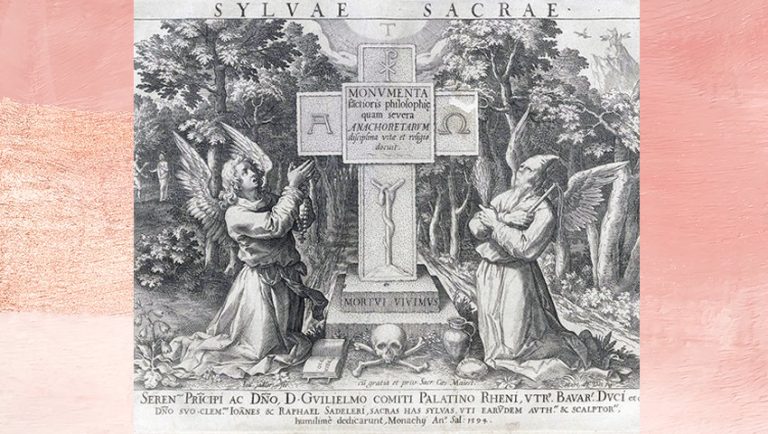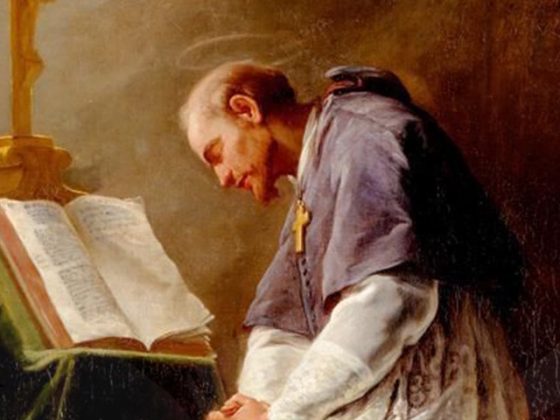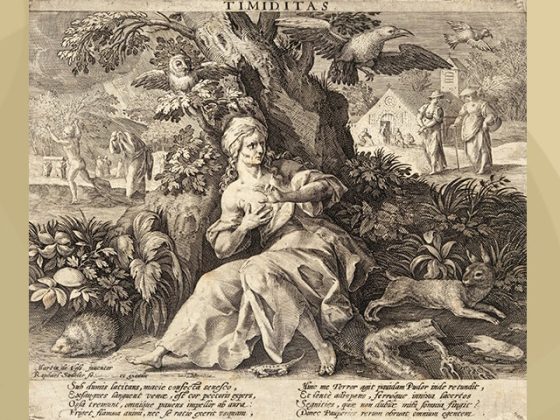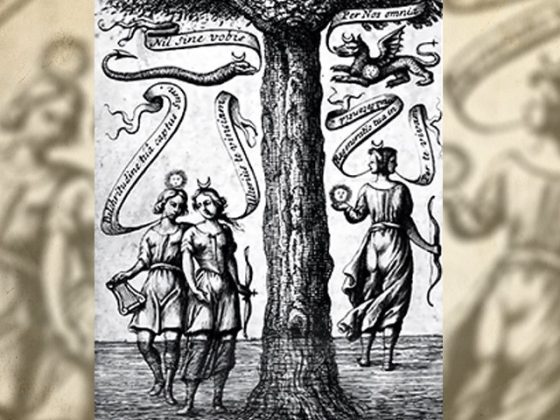Dearest friends:
I now send you an engraving that appears on the first page of a book entitled SYLVAE SACRAE ─'Sacred Forests'─, which contains 29 engravings drawn by Marten de Vos (1532-1603) and by the Sadeler brothers, Johan (1560-1600) and Raphael (1560-1628). The Sadeler family was the largest and probably the most successful of the dynasties of Flemish engravers who dominated printmaking in northern Europe in the late 16th and 17th centuries as artists and publishers.
The book is considered very curious due to the somewhat dark and anachronistic atmosphere in which 29 hermits are depicted in their isolated surroundings in a wild nature outside the cities, some in very harsh self-imposed penances, others in prayer or study, others in a state of ecstasy. Each engraving is accompanied by a short text in Latin.
I attach the first page of the book that has the title written on it…
…SYLVAE SACRAE
─'Sacred Forests'─
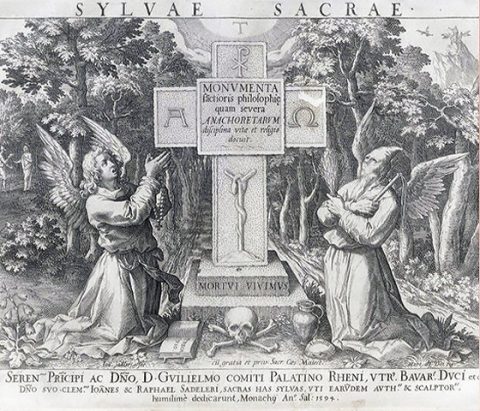
To begin with, we will say that this beautiful engraving shows us in the central part a cross at the top of which is a letter T that is high up in the sky. This letter refers us, dear reader, to the word Theos, which means ‘God' in Greek.
Further down we find at the top of the cross the Christogram or Chrismon, composed of Greek letters CHI and RHO, initials of the word CHRESTOS. This symbol probably accompanied the emperor Constantine in the battle against Maxentius, and was surely linked to the well-known phrase: In hoc signo vinces ─ ‘with this sign you will be victorious.' But this sign has been shown to be more archaic. Unquestionably, from the Gnostic point of view, this emblem holds the key to generating the Sacred Fire in the secret anatomy of the Gnostic ascetic. This image was often depicted on church banners, often surrounded by a circle or victory wreath.
To the left of the vertical beam appears the letter A, indicative of the word Alpha, and to its right the Greek letter O, significant of the word Omega. In short: Here we are told that God is the beginning and the end of all things visible and invisible.
We see a plaque in the center of the cross that reads:
MONVMENTA
Sactioris philosophie
quam severa
ANACHORETARUM
disciplina vitae et religio docuit.
Translation: ‘Monuments of the holiest philosophy that the severe discipline of life and religion of the anchorites taught.'
In the lower part of the cross we can see a snake coiled on a staff. This reminds us of those biblical words that tell us: “Just as Moses lifted up the serpent on the rod, so must the Son of Man be lifted up ─within us─”…..
It is indubitable that our redemption is only possible by means of the help of the Cross. That is the most ancient hieroglyph indicative of the power to create fire. Only with the bond of the lingam and the yoni are the flaming forces of the Third Logos set in motion, which allow us to raise our igneous serpents on the staff that allegorizes our spine. This is the great mystery of the Cross.
At the foot of the holy cross we find another inscription: MORTVI VIVIMOS, ‘dead we live.' This phrase could be interpreted as “after we have died we live,” but in reality the esoteric sense of it is that we live but we are dead. Yes, we live for the world but we are dead to the Spirit…..
On both sides of the cross we can see two characters. The one to the left of it represents an angel. This angel is in an attitude of prayer and therefore carries a rosary in his hands. It is the image of the solar dynasties that are always watching over us, those who suffer in this valley of tears –the material world– trying to assist us emotionally to abandon the yoke that torments us and that is produced by our ANIMAL EGO –the psychological EGO of each one of us–. The other character is an anchorite who is on his knees and carries in one hand a whip or scourge and in the other a branch of thorns. This anchorite symbolizes the VOLUNTARY SUFFERINGS AND CONSCIOUS SACRIFICES that we all need to practice to take away strength from the Beast, composed of ten thousand psychological aggregates that subjugate us night and day throughout our lives. We need to interiorize more and more to distance ourselves from the tenebrous vibrations of the wicked one of which Paul of Tarsus spoke to us in his epistles.
At the feet of the angel is a book with a title: Precatio, which means ‘prayer' or ‘prayers'.
Also at the feet of the penitent we see a BREAD and an AMPHORA. On the bread is written the word Abstinetia, which is to be read as ‘Abstinence.' Certainly, many anchorites practiced abstinence throughout their lives trying to get closer to the profound inner BEING. This is the same thing that our Patriarch SAMAEL always recommended to discipline ourselves in order to live the Secret Path. We are referring here to fasting.
Between the book and the bread with the amphora, we are shown a skull resting on two tibias. This symbol is indicative of that esoteric maxim that goes like this: “Let the flesh leave the bones.” Only with death does the new come.
The whole scene takes place in a forest. It is the forest of existence, which we must take advantage of to rediscover ourselves, in other words: to merge with our true reality, our BEING…
At the far end of the forest, on one side ─left─, we can see the biblical scene of Jesus tempted by the devil in the desert and rejecting his offers.
Another interesting thing is that the anchorite's face appears disfigured. This could mean that our personality has to disappear to be supplanted by the true identity that must represent us and that is none other than that of the BEING.
Likewise, by sharpening our eyes, we can observe certain steps that start from the back of the cross leading toward the heavens. That is our journey with which we will ascend to the kingdom of the Most High.
Below the whole of our engraving we find the following phrases written in Latin: Congratia ac privilegio Sacri Caesaris maiestatis. Translation: ‘With the favor and privilege of the majesty of sacred Caesar.' Caesar was the way to indicate the lords who reigned in the territories of the principalities of the German Empire.
On the bottom left this other Latin phrase appears: Ioannes Sadler Fecit. Translation: ‘Joan Sadler made it.'
On the right: Martin de Vos figuravit, ‘Maerten de Vos conceived it.'
Finally we read this other one in Latin:
Serenissimo Principi ac Domino, Domino Gvilielmo. Comiti Palatino Rheni, Utriusque Bavariae duci etc., Domino suo Clementissimo Ioanes ac Raphael Sadeleri, sacras has sylvas, vti earvdem avthores ac scalptores, humilime dedicarunt, Monachy Anno Salvatoris 1594.
Translation: ‘To the most serene prince, Lord William Count Palatine of the Reindeer, Duke of both Bavarias, etc., to their most clement Lord, Johan and Raphael Sadler humbly dedicated these sacred forests, as authors and engravers of the same in Munich, year of the Saviour: 1594'.
I now give you a few sentences for your reflection:
“If you have faith, you will find that the road to virtue and happiness is very short.”
Quintilian
“The man of faith is eternal in his hope.”
Lucas Fernández de Ayala
“To know if anyone believes in God, I would ask him if he believes in the truth.”
Balmes
“Just as the quality of yellow gold is tested only in fire, so faith is tested only in the time of adversity.”
Ovid
“Faith is believing in what one does not see, and the reward is seeing what one believes.”
St. Augustine
SEMPER FIDELIS.
─‘Always faithful’─.
KWEN KHAN KHU


